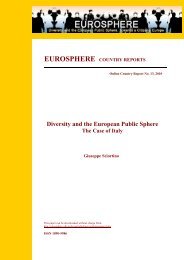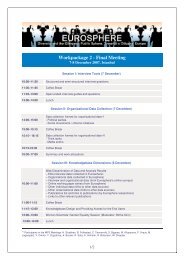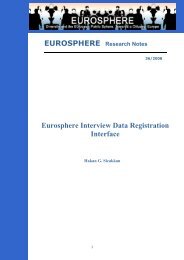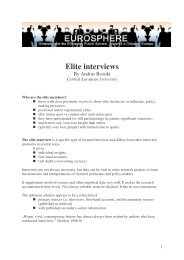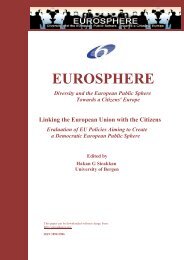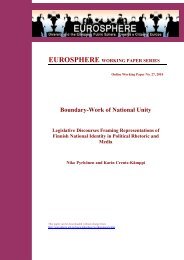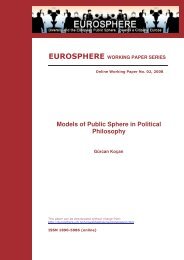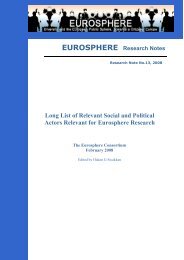Migrants, Minorities, Belongings and Citizenship. Glocalization and ...
Migrants, Minorities, Belongings and Citizenship. Glocalization and ...
Migrants, Minorities, Belongings and Citizenship. Glocalization and ...
You also want an ePaper? Increase the reach of your titles
YUMPU automatically turns print PDFs into web optimized ePapers that Google loves.
Table 16. Explanatory Powers of the Three Models<br />
Explanatory Model<br />
Dominant<br />
variables<br />
Multiple-R<br />
R-Square<br />
Content-<br />
1<br />
Content-<br />
2<br />
Content-<br />
1<br />
Content-<br />
2<br />
Content-<br />
1<br />
Content-<br />
2<br />
The belonging model All (+/–)<br />
Political<br />
belonging<br />
(+)<br />
,914 1,000 ,835 1,000<br />
The mobility model<br />
Mobility<br />
of mind<br />
(general)<br />
(+)<br />
Mobility<br />
of mind<br />
(general)<br />
(–)<br />
,763 1,000 ,581 1,000<br />
The participation model All (–) All (+) ,833 ,862 ,695 ,743<br />
Dependent variables:<br />
Content 1: (mis)alignments in national <strong>and</strong> glocal spaces versus essentialized spaces<br />
Content 2: (mis)alignments in national <strong>and</strong> essentialized spaces versus glocal spaces<br />
Table 16 illustrates measures for each model’s explanatory power. We have already<br />
presented the predictions of these models in the preceding sections. The belonging <strong>and</strong><br />
mobility models have given the highest ratios of accounted variance (R-square). The<br />
participation model accounts for a very large portion of the variance in both of the<br />
misalignment variables. However, the belonging <strong>and</strong> mobility models each account for<br />
much larger portions of the variance in each of the two (mis)alignment dimensions. The<br />
belonging model seems to provide the best predictors for the first (mis)alignment<br />
dimension, followed by the mobility model, which contains the second best set of<br />
predictors. The belonging <strong>and</strong> mobility models have equal predictive power concerning<br />
the second (mis)alignment dimension.<br />
In further analyses, the categorical associations between the mobility variables <strong>and</strong> the<br />
belonging variables were found to be from weak to moderate. However, the two models<br />
– the belonging <strong>and</strong> mobility models – each account for very high portions of the<br />
variation in the two misalignment dimensions. Since these are two different models<br />
whose variables are relatively independent from each other, this means that the<br />
variances that the mobility <strong>and</strong> belonging models account for are different from each<br />
other. While digesting this result, it should be kept in mind that this analysis is with<br />
discontinuous, discrete categorical variables. In other words, it is about associations<br />
between the variables’ ordinal categories rather than the variables themselves.<br />
97



